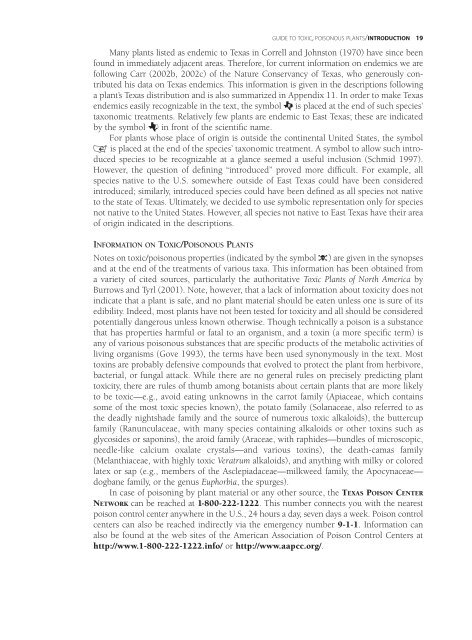ILLUSTRATED FLORA OF EAST TEXAS - Brit - Botanical Research ...
ILLUSTRATED FLORA OF EAST TEXAS - Brit - Botanical Research ...
ILLUSTRATED FLORA OF EAST TEXAS - Brit - Botanical Research ...
You also want an ePaper? Increase the reach of your titles
YUMPU automatically turns print PDFs into web optimized ePapers that Google loves.
GUIDE TO TOXIC, POISONOUS PLANTS/INTRODUCTION 19<br />
Many plants listed as endemic to Texas in Correll and Johnston (1970) have since been<br />
found in immediately adjacent areas. Therefore, for current information on endemics we are<br />
following Carr (2002b, 2002c) of the Nature Conservancy of Texas, who generously contributed<br />
his data on Texas endemics. This information is given in the descriptions following<br />
a plant’s Texas distribution and is also summarized in Appendix 11. In order to make Texas<br />
endemics easily recognizable in the text, the symbol E is placed at the end of such species’<br />
taxonomic treatments. Relatively few plants are endemic to East Texas; these are indicated<br />
by the symbol T in front of the scientific name.<br />
For plants whose place of origin is outside the continental United States, the symbol<br />
I is placed at the end of the species’ taxonomic treatment. A symbol to allow such introduced<br />
species to be recognizable at a glance seemed a useful inclusion (Schmid 1997).<br />
However, the question of defining “introduced” proved more difficult. For example, all<br />
species native to the U.S. somewhere outside of East Texas could have been considered<br />
introduced; similarly, introduced species could have been defined as all species not native<br />
to the state of Texas. Ultimately, we decided to use symbolic representation only for species<br />
not native to the United States. However, all species not native to East Texas have their area<br />
of origin indicated in the descriptions.<br />
INFORMATION ON TOXIC/POISONOUS PLANTS<br />
Notes on toxic/poisonous properties (indicated by the symbol ) are given in the synopses<br />
and at the end of the treatments of various taxa. This information has been obtained from<br />
a variety of cited sources, particularly the authoritative Toxic Plants of North America by<br />
Burrows and Tyrl (2001). Note, however, that a lack of information about toxicity does not<br />
indicate that a plant is safe, and no plant material should be eaten unless one is sure of its<br />
edibility. Indeed, most plants have not been tested for toxicity and all should be considered<br />
potentially dangerous unless known otherwise. Though technically a poison is a substance<br />
that has properties harmful or fatal to an organism, and a toxin (a more specific term) is<br />
any of various poisonous substances that are specific products of the metabolic activities of<br />
living organisms (Gove 1993), the terms have been used synonymously in the text. Most<br />
toxins are probably defensive compounds that evolved to protect the plant from herbivore,<br />
bacterial, or fungal attack. While there are no general rules on precisely predicting plant<br />
toxicity, there are rules of thumb among botanists about certain plants that are more likely<br />
to be toxic—e.g., avoid eating unknowns in the carrot family (Apiaceae, which contains<br />
some of the most toxic species known), the potato family (Solanaceae, also referred to as<br />
the deadly nightshade family and the source of numerous toxic alkaloids), the buttercup<br />
family (Ranunculaceae, with many species containing alkaloids or other toxins such as<br />
glycosides or saponins), the aroid family (Araceae, with raphides—bundles of microscopic,<br />
needle-like calcium oxalate crystals—and various toxins), the death-camas family<br />
(Melanthiaceae, with highly toxic Veratrum alkaloids), and anything with milky or colored<br />
latex or sap (e.g., members of the Asclepiadaceae—milkweed family, the Apocynaceae—<br />
dogbane family, or the genus Euphorbia, the spurges).<br />
In case of poisoning by plant material or any other source, the <strong>TEXAS</strong> POISON CENTER<br />
NETWORK can be reached at 1-800-222-1222. This number connects you with the nearest<br />
poison control center anywhere in the U.S., 24 hours a day, seven days a week. Poison control<br />
centers can also be reached indirectly via the emergency number 9-1-1. Information can<br />
also be found at the web sites of the American Association of Poison Control Centers at<br />
http://www.1-800-222-1222.info/ or http://www.aapcc.org/.
















